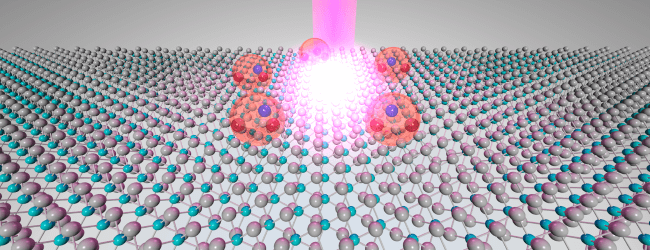Are Dark Trions The New Carrier of Quantum Information?
| 19-08-2019 | By Rob Coppinger
The first working Tungsten Diselenide based device that uses dark trions to transport data is to be built by researchers at the University of California Riverside.
Trion transmission allows more information to be sent than individual electrons, which are the basis for all electronic computing. While electronics today use individual electrons to conduct electricity and transmit information because trions carry a net electric charge their motion can be controlled by an electric field. As such Trions have controllable angular and orbital momentum and a rich internal structure, which can be used to encode information; more information than electrons. Trions are compatible with the semiconductor material, Tungsten Diselenide, also known by its formula, WSe2.

Credit: University of California Riverside
“We intend to demonstrate the first working device that uses dark trions to transport information,” said University of California Riverside (UCR) physics and astronomy assistant professor, Chun Hung Lui. “If such a prototype trion device works, dark trions can then be used to transport quantum information.”
A trion is a quantum bound state of three charged particles. Because a trion contains three interacting particles, it can carry much more information than a single electron. Lui and his team have already observed, characterized, and controlled dark trions in what they describe as an “ultraclean single-layer,” of WSe2.
Bright and Dark Trions
Trions are described as bright or dark. A bright trion emits a lot of light and contains an electron and a hole with opposing spin momentum. A hole is where an atomic position within the microstructure of, for example, a semiconductor, should have an electron, but there is not one. This hole within the atomic structure behaves like a positively charged particle. A dark trion emits less light and contains an electron and a hole, but both have the same spin momentum.
Researchers are using dark trions with the WSe2 device as they exist for longer, more than 100 times longer than bright trions, making information transportation possible over a much longer distance. Bright trions decay quickly, while dark trions decay much more slowly. Trions can also be negative or positive. A negative trion contains two electrons and one hole; a positive trion contains two holes and one electron. Lui’s researchers were able to continuously tune dark trions from being positive to negative by changing an external voltage.
Lui explained that the majority of trion research uses bright trions because they are easier to measure as they emit a lot of light. Using a single-atom two-dimensional sheet of WSe2, the researchers found that dark trions can accumulate within the structure and this large population of dark trions makes it possible to detect them, and therefore able to carry useful data.
The research was supported by UCR start-up funding. Researchers from the National High Magnetic Field Laboratory in Florida and Japan’s National Institute for Materials Science also participated in the research.
